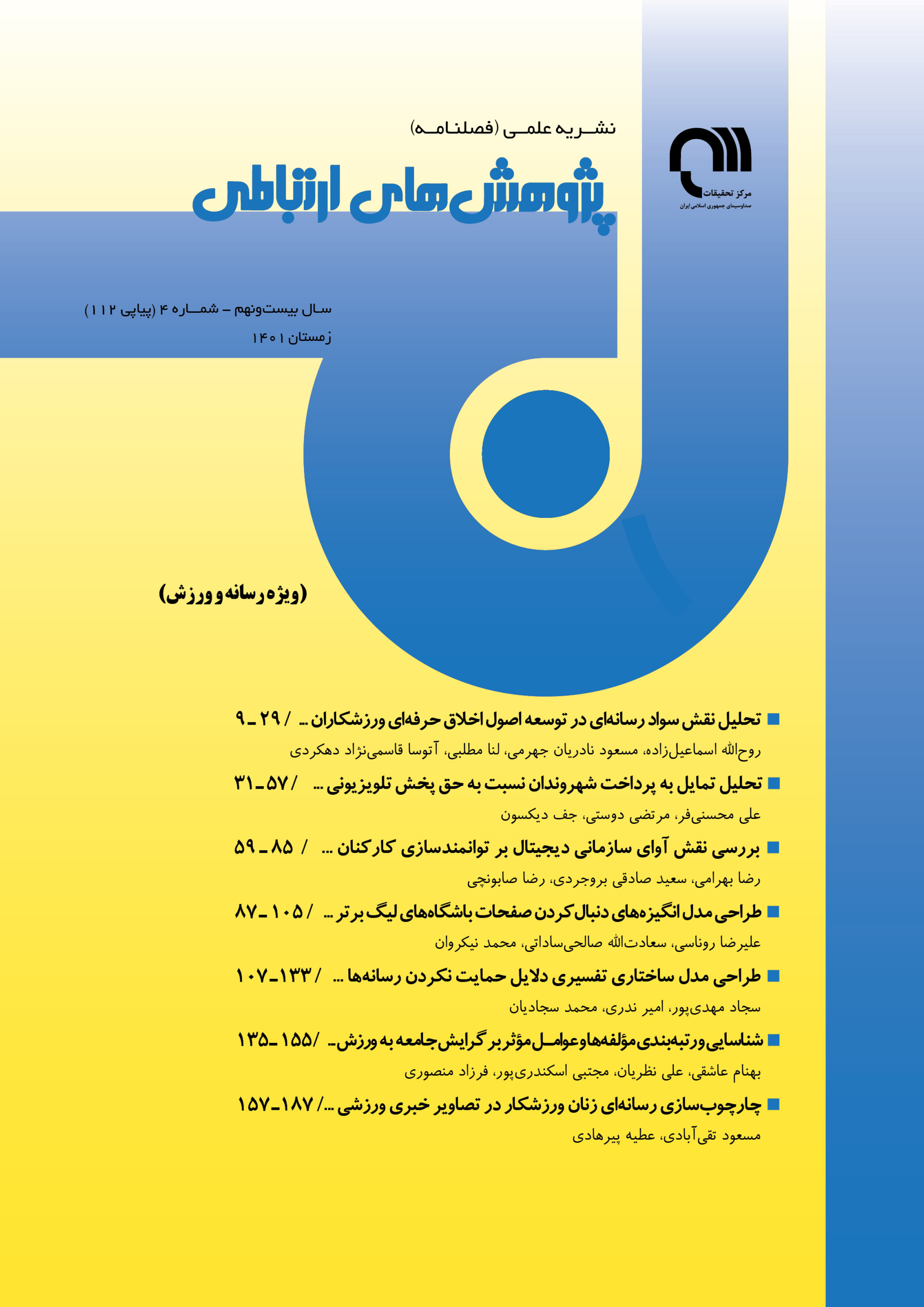نوع مقاله : مقاله پژوهشی
نویسندگان
1 دانشجوی دکتری مدیریت ورزشی گروه تربیت بدنی، واحد شوشتر، دانشگاه آزاد اسلامی واحد شوشتر، ایران
2 استادیار گروه تربیت بدنی، واحد ایذه، دانشگاه آزاد اسلامی ، ایذه، ایران
3 استادیار گروه تربیت بدنی، واحد شوشتر، دانشگاه آزاد اسلامی، شوشتر، ایران
چکیده
هدف از این پژوهش، طراحی مدل ساختاری تفسیری دلایل حمایت نکردن رسانه ها از مدیریت استعداد در فوتبال ایران با رویکرد مدلسازی ساختاری تفسیری بوده است. پژوهش حاضر از نوع آمیخته (کیفی و کمی) است. در گام اول، روش پژوهش کیفی با استفاده از تحلیل مضمون و در گام دوم روش کمی بر اساس مدلسازی ساختاری تفسیری به کار گرفته شده است. جامعه آماری را در هر دو بخش کیفی و کمی، باتوجهبه خبره محور بودن رویکرد مدلسازی ساختاری تفسیری، گروهی از خبرگان، شامل استادان حوزه مدیریت ورزشی و رسانههای ورزشی، مدیران فدراسیون فوتبال و هیئت های استانی تشکیل دادهاند که همگی مورد مصاحبه قرار گرفتهاند. از دو روش تحلیل مضمون (نرم افزار مکس کیودی ای) و مدلسازی ساختاری تفسیری (ISM) (نرم افزار اکسل) برای تجزیهوتحلیل دادهها استفاده شده است. 5 مضمون اصلی برای دلایل حمایت نکردن رسانه ها از مدیریت استعداد در فوتبال ایران شناسایی شدهاند: ماهیتی، مدیریتی، انسانی، امکانات و اقتصادی. عوامل ماهیتی و امکانات، متأثر از عوامل دیگرند و بر این عوامل، تأثیر اندکی دارند. عوامل مدیریتی و اقتصادی بر سایر عوامل تأثیرگذارند و خود نیز از آنها تأثیر می گیرند و در نهایت عامل انسانی، خود بر عوامل دیگر تأثیر زیاد دارد اما تأثیر عوامل دیگر بر آن اندک است.
تازه های تحقیق
پژوهش حاضر با محدودیتهایی نیز مواجه بوده است که از آن جمله میتوان به محدودیتهای پژوهشی در زمینه همکاری جامعه ورزش و رسانه در حوزه استعدایابی ورزشی، سواد رسانهای محدود کارشناسان استعدایابی ورزشی، تمرکز رسانهها بر پوشش مسابقات پرطرفدار و نداشتن گرایش به برنامههای آموزشی و زمینهای اشاره کرد.
امید است که نتایج پژوهش حاضر، زمینه بهبود همکاریهای مشترک ورزش و رسانه را در حوزه استعدادیابی فراهم آورد.
کلیدواژهها
موضوعات
عنوان مقاله [English]
Designing an Interpretive Structural Model of the Reasons for Media not Supporting Talent Management in Iranian Football
نویسندگان [English]
- Sajjad Mehdipour 1
- Amir Nadri 2
- Mohammad Sajjadian 3
1 Ph.D. Student in Department of Sports Management, Shoushtar Branch, Islamic Azad University, Shoushtar, Iran
2 Assistant Prof. In Department of Physical Education, Izeh Branch, Islamic Azad University, Izeh Branch, Iran
3 Assistant Prof. In Department of Physical Education, Shoushtar Branch, Islamic Azad University, Shoushtar , Iran
چکیده [English]
The purpose of this research is to design an interpretive structural model of the reasons for media not supporting talent management in Iranian football with an interpretive structural modeling approach. The research conducted by mixed method (qualitative and quantitative). In the first step, thematic analysis and in the second step, interpretative structural modeling was done. The statistical population in both qualitative and quantitative parts, due to the expert-centeredness of the interpretive structural modeling approach, included a group of experts, including professors in the field of sports management and sports media, managers of the football federation and provincial boards, all of whom were interviewed. Two methods of thematic analysis (MAXQDA software) and Interpretive Structural Modeling (ISM) (Excel software) were used to analyze the data. Five main themes were identified for the reasons of media not supporting talent management in Iranian football: nature, managerial, human, facilities and economic. Nature and facilities factors are affected by other factors and have little effect on the others. Management and economic factors affect other factors and are affected by them, and finally, the human factor itself has a great influence on other factors, but the influence of other factors on it is small.
کلیدواژهها [English]
- Nature
- Management
- Human
- Facilities
- Economic

